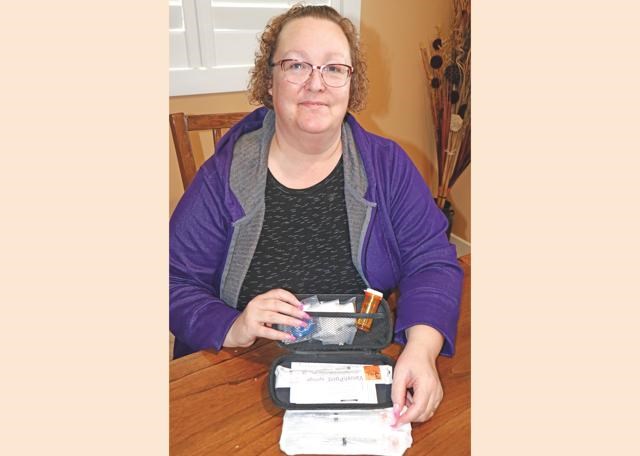Denise Kennedy has had a naloxone kit available in her home for the past couple of years, but she hopes she never has to use it.
The Weyburn resident has an adult daughter who is a drug addict, and after the daughter nearly died of a Fentanyl overdose, she obtained a kit plus the proper training for administering it from Addictions Services. (Her daughter’s name is not being used to protect her identity.)
Denise’s daughter has overdosed a number of times, but the experience with Fentanyl was perhaps the worst. Someone she was with at the time had a naloxone kit, which was used, but the EMTs still had to perform CPR on her once they responded.
“My daughter asked me to get a naloxone kit, so I did. She wanted to get one also, but she hasn’t got one yet,” said Denise, noting that Addictions Services provided her with one hour of training to use the naloxone.
“They asked if I knew the signs of an overdose. With my daughter being addicted for so many years, we know some of the signs to look for,” said Denise.
These signs include blue lips and fingernails, being unresponsive, and at times there will be what her daughter calls a “death gurgle” in the throat before the breathing stops. If they are still conscious, the pupils will be like a pinpoint. Other signs of an overdose include excessive drowsiness, pale and clammy skin, and slow or no heartbeat.
Naloxone will counteract the effects of opioids including heroin and morphine, as well as Fentanyl.
Now in her late 20s, her daughter began her substance abuse when she was 15, starting with alcohol and marijuana use, before she began snorting Ritalin.
“She always said she’d never shoot up, but she did get to that point with heroin use,” said Denise, noting her daughter left home as soon as she was able to, at the age of 16, “because she knew we couldn’t stop her.”
Over the years, her daughter has been to detox programs a number of times, including to Pine Lodge at Indian Head.
“It’s not that they don’t learn from it,” said Denise. “She takes home something different every time.”
Denise noted she has gone up to Pine Lodge when her daughter was being treated, and the staff there are very helpful to family members of patients, plus it helps to be able to talk to the families of other addicts.
Her daughter had two children, and Denise has adopted the older one, a girl who is now nine years old, while a son is in foster care through Social Services. She has had her granddaughter since she was one year old.
In Denise’s view, the naloxone kits should be more universally available, like the automatic defibrillator machines are in most public facilities, and said anyone can take the training for it.
“With the nasal spray, even kids can use it, such as if they have a parent or relative who is an addict,” added Denise.
“I hope everyone considers getting the training,” she said. “Every addict is somebody’s loved one.”
Within the southeast area of the Saskatchewan Health Authority, take-home naloxone kits are stocked and available, free of charge and without appointment, at either of the Addiction Services offices in Weyburn (900 Saskatchewan Drive) and Estevan (1176 Nicholson Road) during the office hours of 8 a.m. to 5 p.m. Kits are also available at any of the hospital emergency rooms 24 hours a day. Each kit includes three ampules of naloxone and training on overdose response is available on the spot. The Saskatchewan Health Authority strongly encourages that anyone not familiar with using the kit receive the training.
“The goal of the publicly funded take-home naloxone program is to distribute naloxone and provide training in recognizing and responding to overdose in order to prevent death and reduce brain injury or brain damage,” said Jody Miller, supervisor of Addiction Servicesat the Community Health Services building in Weyburn.
“It also encourages individuals to seek treatment as an important component in addressing opioid misuse.”




